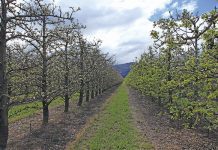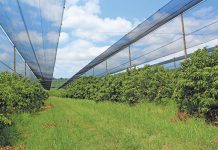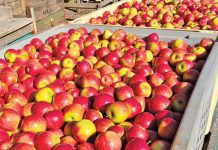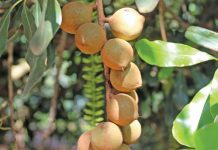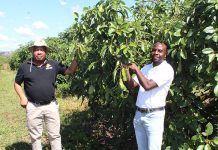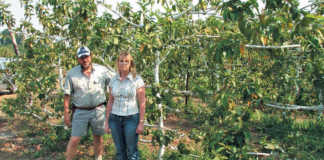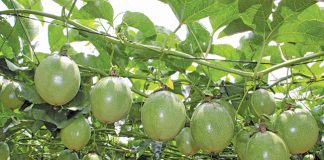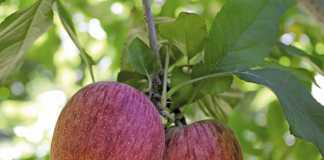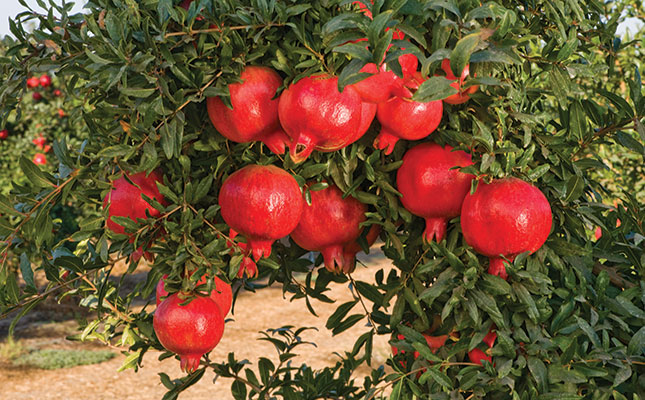
Photo: Marita Meyer
In March 2021, Farmer’s Weekly reported on how Gerhard Meyer transformed the farm he inherited near Oudtshoorn in 2008 by building a dam to store his water allocation. He also installed a desalination plant to make the water more suitable for fruit production and converted 15ha of lucerne under flood irrigation to 40ha of pomegranate under drip irrigation.
In addition, he changed the farm’s name from Langverwacht to Celebratio, in remembrance of the happy times he spent there as a child and in honour of his father, grandfather and other relatives who managed to keep the farm in the family despite severe hardships.
Since then, he has established an independent pomegranate brand that will enable other farmers to cash in on production of this crop in the Klein Karoo.
“Pomegranates present the best return on investment in terms of land and water usage of all crops in this part of the Klein Karoo. The yield per litre of water is second to none,” says Meyer.
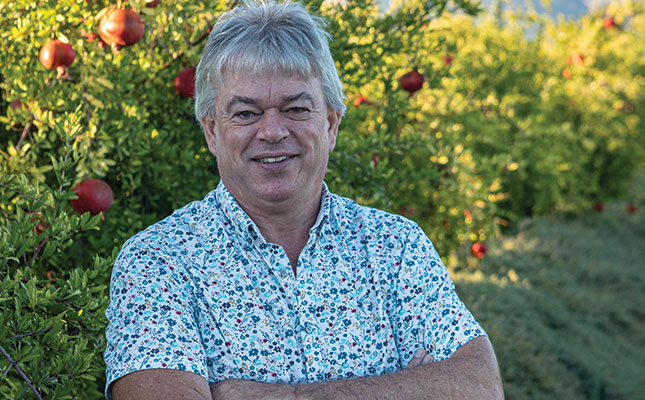
He adds that the crop also has excellent job creation potential, with 1,5 jobs being created for every hectare planted.
“Establishing a pomegranate industry here will breathe new life into the job market. The Oudtshoorn area is currently sitting with an unemployment rate of 80%. Many jobs were lost when local farmers downscaled because of the effects of the COVID-19 pandemic, avian influenza, and the onset of the drought about seven years ago.
“We conducted a survey to identify the pool of farmworkers in the area and the skills shortages that need to be addressed to facilitate the pomegranate initiative. We need to reskill at least 350 workers to support the new industry.”
Huge demand in other countries
In 2008, when exploring which crop options would work best for him, Meyer was struck by the many advantages of pomegranates. Crucially, they suited the hot, dry climatic conditions of the Oudtshoorn region, and this was reinforced while he was in Israel looking at various production choices. An elderly farmer said that he would “never go wrong when producing fruit from the Bible”.
In addition, there was already a growing demand for pomegranates, thanks to its reputation as a ‘superfood’. These fruits, explains Meyer, are packed with antioxidants, fibre, vitamins, minerals and other nutrients that are reputed to prevent certain types of disease.
Another advantage of pomegranates lies in pricing. The Southern Hemisphere accounts for a mere 5% of global production, with Peru contributing the most to this figure. This undersupply has a major impact on prices, with pomegranates from the Southern Hemisphere selling for R25 000/t to R28 000/t, in comparison with about R14 000/t for fruit sold during the high season of the Northern Hemisphere, according to Meyer.
The Wonderful variety planted in Oudtshoorn usually ripens from the end of February to mid-March, and gets to retail shelves overseas when they are still relatively empty.
Demand is especially high in Jewish and Muslim communities, who are familiar with the fruit.
Iran is the world’s third-largest producer of pomegranates, but imports about 61 000t of the fruit annually. South Africa, however, currently exports only about 6 300t of pomegranates a year, according to the Pomegranate Producers‘ Association of South Africa.
Meyer adds that increasing production would be unlikely to change the Southern Hemisphere’s price advantage. This is firstly because areas that have an arid climate, yet
have available irrigation, like Oudtshoorn, are not easily found, and secondly, because high labour costs internationally are holding back expansion.
The potential export of Class 2 pomegranates holds yet more positive news for South African producers. While export pomegranates, like all export fruit, have to comply with very high quality standards, North African communities in Britain have been asking retailers to import Class 2 pomegranates at lower prices, as they know that slight skin damage and blemishes have no effect on eating quality or nutritional value. This, says Meyer, could unlock new export opportunities.
Wonderful pomegranates
Asked why he chose the Wonderful pomegranate cultivar, Meyer says that in 2008 it was the only variety he could get that was not subject to membership of a growers’ club and subsequent royalties. Fortunately, it was also the world’s most popular cultivar, and suitable for the fresh export, processing and juice markets.
“I have a marketing background, so don’t see myself as a franchisee. I want to create my own value, not build on value created by others,” he says.
A contact from Israel informed him that Wonderful trees were exported to a nursery in South Africa, and by sheer coincidence, the nursery happened to belong to one of Meyer’s old friends from Stellenbosch University, Willem van der Merwe.
“When Willem asked me how many trees I wanted, I said I’d take the lot!” Meyer recalls.
The Wonderful variety turned out to be a winner in the Klein Karoo and it is currently planted on about 750ha in various parts of South Africa, including Bonnievale and Wellington in the Western Cape, as well as in Limpopo. None of these areas, however, can match the quality and colour of the fruit produced around Oudtshoorn, claims Meyer.
“Our pomegranates are significantly redder and sweeter because of our hot and semi-arid climatic conditions, which are quite similar to those of southern Israel, where the variety comes from. Wonderful thrives here because we’re farming the right variety in the right place,” he says.
Another advantage of this part of the Klein Karoo is that the region lends itself to organic production.
“The disease and pest pressure is quite low because our farms are isolated and the weather is hot and dry. We don’t use harsh chemicals, as people eat pomegranates for health reasons.”
An Independent brand
Meyer’s idea of creating an independent brand for fruit produced in the region was met with enthusiasm by Sapex, the company that exports his pomegranates. Together, they calculated that at least 200ha of pomegranates would be needed to create a sustainable brand.
Meyer then convinced eight farmers in or near Oudtshoorn to plant 160ha in total to the crop in August 2021. Combined with the 40ha on his farm, Meyer met the target of 200ha. Keen to boost production, however, Meyer is currently campaigning to get more farmers on board to plant an additional 100ha.
“I’d like to see us get to 300ha, if there’s enough water, and to turn Oudtshoorn into the pomegranate mecca of South Africa,” he says.
The group has already registered the Karoo Wonderful Pomegranates brand and aims to launch the first exports by March next year.
Meyer says that pomegranate production has met with mixed success elsewhere in South Africa, with fewer than 1 500ha of various cultivars planted. He ascribes this to farmers planting the wrong varieties in the wrong places, and the misconception that pomegranates are a hardy crop that requires little attention.
“The truth is that pomegranate production is just as intensive as that of any other crop aimed at the export market,” he stresses.
On the other hand, getting it right is not ‘rocket science’. Meyer points out that he does not have a farming background, but relies on consultants to guide his production protocols, which include building soil health, fertilisation, irrigation management, and pest management.
Farmers participating in the Karoo Wonderful programme are given as much support as possible. For example, they don’t require on-farm packing facilities, as all the fruit will be packed at Karoo Pak’s Global GAP-certified packhouse.
Enticing profits
Meyer says that it is cheaper to establish pomegranate orchards than those of other fruit, with the cost ranging from R80 000 to R100 000 for 1 000 trees/ha, including irrigation.
(Planting density has increased significantly in recent years, he notes; when he established his orchards, the norm was 666 trees/ha.)
An additional R60 000/ha is needed to put the trees on a trellis system, which is usually done during the second year of production. “My trees aren’t on a trellis system, but it reduces sunburn and wind damage significantly,” says Meyer.
Yields of 8t/ha are conservatively achievable from the third year after planting, 15t/ha to 18t/ha from the fourth year, and 20t/ha to 25t/ha from the fifth year. The trees reach maturity in the sixth year, by which time production ranges between 28t/ha and 35t/ha.
Meyer says the general consensus in South Africa is that pomegranate trees don’t last longer than 30 years, but he saw trees in Turkey and Israel older than 40 years that were producing more than 45t/ ha.
“Pomegranate production is still relatively new in South Africa, so in the absence of local research, we’re still fine-tuning production and basically writing the manual as we go along,” he says.
Break-even is reached from the fourth to fifth year of production, depending on the production environment and farming efficiency, with profits conservatively ranging between R120 000/ha and R200 000/ha once the trees are in full production. This is dependent on good orchard management and a certain percentage of Class 1 fruit being produced.
Value-adding
Typically, 10% or so of the crop is lost due to sunburn damage and cracks, and between 40% to 50% ends up on the processing market. This leaves only 40% to 50% achieving export quality. With enough care, however, a farmer should be able to push the export percentage to over 60%, says Meyer.
To add value to the Oudtshoorn area and the harvest, Meyer and a number of local farmers have established Karoo Pak, a packhouse that will cater for the pomegranates produced by the entire group of Karoo Wonderful growers.
In addition, they are ”looking for innovative ways to add value to production”. They have already launched 100% pure pomegranate juice, which is sold in a frozen form, but product development is being carried out to manufacture juice with a longer shelf life.
“The frozen juice gets lost among all the other frozen goods [in a retailer]. We want the product to have a stronger presence. The trick is to ensure that the long-life treatment doesn’t subtract from the nutritional value of the product, but rather enhances it,” says Meyer.
He explains that in California in the US the whole fruit is juiced, but he and his team have used only the arils (seeds) when making juice.
“The pips and pith give the pomegranates an astringent taste, so we’re looking at alternative [uses] for the pips, for example by making pomegranate oil, which is in high demand in the cosmetics industry.”
He adds that the fruit is highly versatile, with even the dried skins being used to brew tea as an aid for digestive problems. The farmers are also studying the nutritional value of the pulp to determine its use as animal feed.
“We want to get into a position where we add all the value in the Oudtshoorn region. This will lead to more job creation and a higher farm income for participating producers,” says Meyer.
He adds that there is still much room for developing the local market for pomegranates.
“They’re not big in South Africa because retailers charge high prices for inferior fruit. There’s good market potential, but it’ll need consumer education on the health properties and ways to eat the fruit.
“For now, our focus is on increasing production with new farmers joining the group, developing the export brand, and finding innovative ways to add value to lower-grade fruit. We’ll look at the local market after that.”
Email Gerhard Meyer at [email protected].


